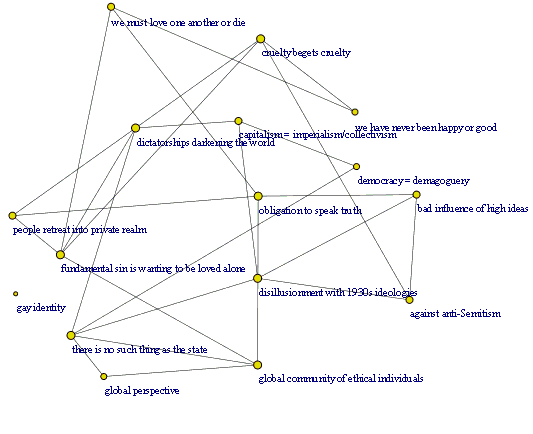- Facebook288
- Total 288

We can think of a person’s moral mentality as a network. The nodes are ideas or values; the links are various kinds of connections among the ideas: implications, explanations, influences, and meaningful tensions. For instance, I believe that all human beings have exactly equal value, yet I also believe that my primary obligations are to my own family. These are two nodes in my personal moral network, connected not by a contradiction but by a tension.
A good moral mind comprises important and correct nodes. For instance, it is better sincerely to endorse a principle of equality than to advocate hating some of one’s fellow human beings. That example shows that a single node can affect–even determine–a person’s character. But it is hard to argue for any given idea all by itself. (Why equality, for instance?) And it is not enough to have the right principles; they must also be well organized.
Those two considerations lead us to think not merely about which principles are right or good, but also about the overall shape of a person’s moral network. Does it include enough ideas to handle the actual complexity and variety of human affairs? Are weighty and serious ideas central to the network? Do ideas just stand by themselves, or are they linked together in meaningful ways?
I’ve been thinking about these questions introspectively–but that is a somewhat private matter. Another way to demonstrate this kind of analysis is to examine the moral network map of a famous person.
A full personality would be an immensely complicated thing to map, since it comprises all kinds of principles, desires, aversions, memories, virtues, vices, memberships and identifications, hopes, plans, skills, and facts. It changes constantly and is inconsistent, replete with thoughts that are only half-endorsed, only half-sincere. But if we are interested in moral questions–What should we do? How should we live?–we can simplify the analysis to a person’s moral ideas.
Most people (including me) are not sure what those are; we would have great difficulty explaining our moral premises adequately to other people. We are not terribly clear or articulate. Fortunately, some writers describe moral ideas cogently and concisely, not merely listing them but putting them in a formal arrangement that reflects appropriate amounts of tension, irony, ambivalence, and ambiguity. Whether the resulting text reflects the author’s sincere, inner motivations doesn’t matter; we are not interested in psychoanalysis, but in finding a moral worldview to analyze. It is the text, not the writer, that we will use for analysis.
Morally conscious lyric poets are especially helpful for this purpose because their writing is concise and is concerned with form and organization as well as discrete ideas. Also, poetry can accommodate abstract concepts, concrete stories, personalities, reasons, and emotions–as the poet sees fit. I don’t believe we should screen out any of these kinds of ideas in advance but should see how they work together in a particular mentality.
Recently, I offered a brief reading of a great and influential moral poem, W.H. Auden’s “September 1, 1939.” I explored the complexities of Auden’s pronouncements, some of which we know he did not mean literally. For instance (as he himself said later), the line “We must love each other or die” is false, since we will die even if we do love each other. So its place in the poem is more complicated than just a proposition that Auden endorsed. The setting–a gay bar on the first night of World War II–may be as important as some of the abstract themes.
One way to think of the structure of the poem is as a literal network map. See the top of this post for an example. To make that image, I selected ideas (and in some cases, quotes) from the poem. I used software to place them in literally random locations on a blank plane, connected the ones that seemed related–using dotted lines for nodes that are in mutual tension–and then applied an algorithm that moves the nodes around as if they were billiard balls connected by springs, until the diagram stabilized at an equilibrium. That yielded a picture of the relationships among Auden’s ideas as presented in this (partly fictional) poem.
An important disclaimer: the labels of those nodes are simplistic; they reduce subtle and ambivalent ideas to slogans. So you must actually read the poem. Nevertheless, the network analysis brings out certain points:
Auden presents a rich view in just a few pages. I found 16 nodes and 52 links, and I’m sure I could have found more. None of these nodes can be collapsed into others, but a few separate areas of emphasis emerge. As shown at the bottom-left of the map, Auden is anti-collectivist: against the state, mass society, and ideologies (including corporate capitalism). He admires personal conscience–but not the retreat into private life.
Another important ideal for him is disinterested love, which is threatened by the universal desire to be loved exclusively.
I put “gay identity” on the map because the setting is known to have been a gay bar, and Nijinsky/Diaghilev (mentioned in the poem) formed a same-sex couple, as did Auden/Kallman. But I can’t connect that node to others because Auden is not explicit about homosexuality. This is a case where what is unstated is also part of the map.